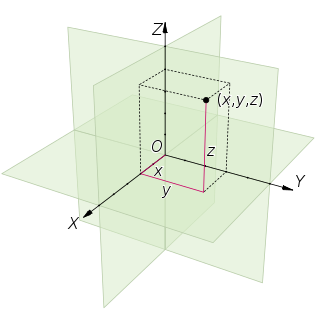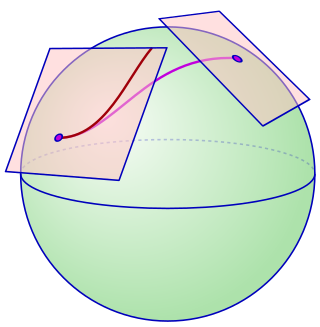In mathematics, an associative algebraA over a commutative ring K is a ring A together with a ring homomorphism from K into the center of A. This is thus an algebraic structure with an addition, a multiplication, and a scalar multiplication. The addition and multiplication operations together give A the structure of a ring; the addition and scalar multiplication operations together give A the structure of a module or vector space over K. In this article we will also use the term K-algebra to mean an associative algebra over K. A standard first example of a K-algebra is a ring of square matrices over a commutative ring K, with the usual matrix multiplication.

Euclidean space is the fundamental space of geometry, intended to represent physical space. Originally, in Euclid's Elements, it was the three-dimensional space of Euclidean geometry, but in modern mathematics there are Euclidean spaces of any positive integer dimension n, which are called Euclidean n-spaces when one wants to specify their dimension. For n equal to one or two, they are commonly called respectively Euclidean lines and Euclidean planes. The qualifier "Euclidean" is used to distinguish Euclidean spaces from other spaces that were later considered in physics and modern mathematics.

In the mathematical field of representation theory, group representations describe abstract groups in terms of bijective linear transformations of a vector space to itself ; in particular, they can be used to represent group elements as invertible matrices so that the group operation can be represented by matrix multiplication.

In mathematics, many sets of transformations form a group under function composition; for example, the rotations around a point in the plane. It is often useful to consider the group as an abstract group, and to say that one has a group action of the abstract group that consists of performing the transformations of the group of transformations. The reason for distinguishing the group from the transformations is that, generally, a group of transformations of a structure acts also on various related structures; for example, the above rotation group acts also on triangles by transforming triangles into triangles.

In mathematics, a Lie group is a group that is also a differentiable manifold, such that group multiplication and taking inverses are both differentiable.

In geometry and physics, spinors are elements of a complex number-based vector space that can be associated with Euclidean space. A spinor transforms linearly when the Euclidean space is subjected to a slight (infinitesimal) rotation, but unlike geometric vectors and tensors, a spinor transforms to its negative when the space rotates through 360°. It takes a rotation of 720° for a spinor to go back to its original state. This property characterizes spinors: spinors can be viewed as the "square roots" of vectors.

In Euclidean geometry, an affine transformation or affinity is a geometric transformation that preserves lines and parallelism, but not necessarily Euclidean distances and angles.

In mathematics, the general linear group of degree n is the set of n×n invertible matrices, together with the operation of ordinary matrix multiplication. This forms a group, because the product of two invertible matrices is again invertible, and the inverse of an invertible matrix is invertible, with the identity matrix as the identity element of the group. The group is so named because the columns of an invertible matrix are linearly independent, hence the vectors/points they define are in general linear position, and matrices in the general linear group take points in general linear position to points in general linear position.

In mathematics and theoretical physics, a representation of a Lie group is a linear action of a Lie group on a vector space. Equivalently, a representation is a smooth homomorphism of the group into the group of invertible operators on the vector space. Representations play an important role in the study of continuous symmetry. A great deal is known about such representations, a basic tool in their study being the use of the corresponding 'infinitesimal' representations of Lie algebras.
In mathematics, the affine group or general affine group of any affine space is the group of all invertible affine transformations from the space into itself. In the case of a Euclidean space, the affine group consists of those functions from the space to itself such that the image of every line is a line.

In mathematics, an affine space is a geometric structure that generalizes some of the properties of Euclidean spaces in such a way that these are independent of the concepts of distance and measure of angles, keeping only the properties related to parallelism and ratio of lengths for parallel line segments. Affine space is the setting for affine geometry.

In mathematics, a homogeneous space is, very informally, a space that looks the same everywhere, as you move through it, with movement given by the action of a group. Homogeneous spaces occur in the theories of Lie groups, algebraic groups and topological groups. More precisely, a homogeneous space for a group G is a non-empty manifold or topological space X on which G acts transitively. The elements of G are called the symmetries of X. A special case of this is when the group G in question is the automorphism group of the space X – here "automorphism group" can mean isometry group, diffeomorphism group, or homeomorphism group. In this case, X is homogeneous if intuitively X looks locally the same at each point, either in the sense of isometry, diffeomorphism, or homeomorphism (topology). Some authors insist that the action of G be faithful, although the present article does not. Thus there is a group action of G on X that can be thought of as preserving some "geometric structure" on X, and making X into a single G-orbit.

In mathematics, a linear algebraic group is a subgroup of the group of invertible matrices that is defined by polynomial equations. An example is the orthogonal group, defined by the relation where is the transpose of .

In differential geometry, an affine connection is a geometric object on a smooth manifold which connects nearby tangent spaces, so it permits tangent vector fields to be differentiated as if they were functions on the manifold with values in a fixed vector space. Connections are among the simplest methods of defining differentiation of the sections of vector bundles.
Verma modules, named after Daya-Nand Verma, are objects in the representation theory of Lie algebras, a branch of mathematics.

In mathematics, a space is a set endowed with a structure defining the relationships among the elements of the set. A subspace is a subset of the parent space which retains the same structure. While modern mathematics uses many types of spaces, such as Euclidean spaces, linear spaces, topological spaces, Hilbert spaces, or probability spaces, it does not define the notion of "space" itself.
In physics and particularly in particle physics, a multiplet is the state space for 'internal' degrees of freedom of a particle; that is, degrees of freedom associated to a particle itself, as opposed to 'external' degrees of freedom such as the particle's position in space. Examples of such degrees of freedom are the spin state of a particle in quantum mechanics, or the color, isospin and hypercharge state of particles in the Standard Model of particle physics. Formally, we describe this state space by a vector space which carries the action of a group of continuous symmetries.

Representation theory is a branch of mathematics that studies abstract algebraic structures by representing their elements as linear transformations of vector spaces, and studies modules over these abstract algebraic structures. In essence, a representation makes an abstract algebraic object more concrete by describing its elements by matrices and their algebraic operations.
In algebraic geometry, given a linear algebraic group G over a field k, a distribution on it is a linear functional satisfying some support condition. A convolution of distributions is again a distribution and thus they form the Hopf algebra on G, denoted by Dist(G), which contains the Lie algebra Lie(G) associated to G. Over a field of characteristic zero, Cartier's theorem says that Dist(G) is isomorphic to the universal enveloping algebra of the Lie algebra of G and thus the construction gives no new information. In the positive characteristic case, the algebra can be used as a substitute for the Lie group–Lie algebra correspondence and its variant for algebraic groups in the characteristic zero; for example, this approach taken in (Jantzen 1987).










